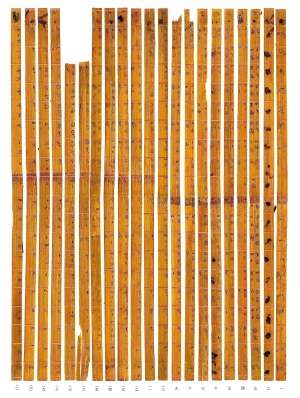January 9, 2014 report
Donated Chinese bamboo strips turn out to be ancient multiplication table

(Phys.org) —Researchers at Tsinghua University in China are reporting that a subset of bamboo strips donated to the university five years ago has been found to make up an ancient Chinese multiplication table. Dated back to 2,300 years ago (circa 305 B.C.), the table represents the oldest-known such device that computes in base 10—ancient Babylonian tables dating back 4000 years were base 60.
The bamboo strips were part of a much larger collection of very old and partially decomposed bamboo strips, all of which had writing on the back. Recently, the researchers separated out the strips that had numbers on the back instead of characters representing letters. Figuring out what the numbers meant was a time-consuming process as they were in random order—the string that once bound them together had decayed thousands of years before. The time during which they were created corresponds to a period just before the Qin Dynasty, when what is now known as China was still divided into several warring states. Each strip is approximately 20 inches long and slightly less than half an inch wide, and the collection is believed to have been part of a set of artifacts retrieved from an ancient tomb which was subsequently lost to illegal trafficking. The person that donated the collection to university had bought it at a market in Hong Kong.
Lining the strips in the right way reveals a table very much like a modern multiplication table—numbers across the sides and tops are used as multiplicands, their intersection points mark the result. Interestingly, the table also allows for multiplying partial numbers between 0.5 and 99.5, though the process requires converting equations into sums first.
The researchers believe the multiplication table was likely used to measure land area, or to predict crop yields. They note the table can also be used to solve division problems, but doubt the people using them had learned of such math at the time. Prior to the new discovery, the oldest known multiplying device found in China was a table dated back to a period a couple of hundred years later than this new table, and it was considerably less useful. The new bamboo table represents a level of mathematical sophistication unheard of for the time, meaning historians will have to revise their estimates of the skill levels of the people that invented the table.
© 2014 Phys.org



















